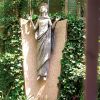Overhaul overdue
The United Nations reports there are 10.5 million refugees in the world. These are homeless, often stateless, mostly impoverished people displaced for many reasons, but frequently due to war and persecution.
New York church welcomes the UN
NEW YORK - It’s known as the United Nations church.
About halfway along 47th Street, just west of the UN’s iconic tower on First Avenue in Manhattan — and in an area known as Dag Hammarskjold Plaza — is Holy Family Church, a name that also reflects its long time roots in the city’s east side neighbourhood, where it also serves 500 families in the community.
The present Holy Family building, a stunningly beautiful modern structure, was dedicated by Cardinal Francis Spellman in 1965, just before Pope Paul VI’s visit to the UN in October of that year. A cornerstone commemorates an ecumenical meeting the pontiff held at the church. The parish actually dates to the 1920s when it was established as the church for the local Turtle Bay Italian neighbourhood.
The church plays a significant role in the UN community by housing the residence and office of the Permanent Observer of the Holy See to the United Nations, as well as offices of national and international UN-related Catholic organizations. The church’s dedication was attended by then UN Secretary General U Thant. Holy Family continues to be the site of many UN religious observances.
“In fact just this past Monday we had a prayer service for the opening of the General Assembly,” Fr. Robert Robbins, the church’s pastor of 23 years, said in a late September interview. Ambassadors and UN personnel attended.
Robbins, a native of the Bronx who is leaving Holy Family for several new roles with the New York archdiocese, including director of community outreach, says the international flavour of the parish creates a unique community.
“It’s always interesting because what we have is a New York City parish which is also attempting to reach out to Catholic members of the UN with different cultural backgrounds, so each time something presents itself — for instance a memorial service or something like that — you’re going to get the mission in from Peru or some other country,” he said.
“It’s just very interesting trying to deal with the language differences, the cultural differences, also the religious expression, because South American countries especially have devotions that wouldn’t be known to us in North America.”
Parishioner Margie Skeels, a former parish council president who works with the UN Development Program, said being a member of the church “raises the level of my faith. Personally I have a chance to live my faith through the UN.”
The building is almost awe-inspiring in its architecture and art work — with sculptures, altars, stained glass and a unique presentation of the Stations of the Cross — created by various international artists, including a Canadian.
The original church was built on a stable because the area between First and Second Avenues once abounded in slaughterhouses. Some of that building is contained in the present structure.
The new church’s architect, George J. Sole, created a church symbolic of a stone monument and which partly harmonizes with the UN building itself. The exterior’s gray granite walls consist of panels with a cruciform pattern surrounded by four squares, representing a community gathered around Christ. The interior is spare, but that complements its breathtaking artistic details.
The altar is made from black granite quarried near the Canadian Arctic, behind which is a towering aluminum sculpture of the Risen Christ with a large testa or crown of lights. It, along with the statues at the two side altars, and the statue of the Virgin Mary in an outside garden next to the church, were made by the Italian studio of Nagni. The side altars represent themes of sacrifice, universality and peace.
The west wall incorporates the related grouping of three large stained glass windows and three ceramic sculptures, referencing the Holy Family’s flight into Egypt with the dispossession of contemporary refugees.
The Stations of the Cross, on the east wall, are one continuous set of sculpted images. In the 11th station, the sculptor has pressed into clay the tools used in the crucifixion. In the 12th, there is a reference to the Manhattan skyline as a backdrop to Christ hanging on the cross.
The stations, windows and ceramics are all from the studio of Catalan-born artist Jordi Bonet, who emigrated to Canada and worked from a studio in Montreal until his death in 1979. His sculptures can be seen as far afield as JFK airport in New York and the Pie-IX subway station in Montreal.
(Stang is a freelance writer in Windsor, Ont.)
Canadian voice sought to bring Congo peace
TORONTO - With a death toll estimated at 5.4 million and climbing and a campaign of rape reshaping the nation, Congolese religious leaders arrived in Canada with a petition signed by more than one million Congolese and a request that Canadians support practical measures for peace at the United Nations.
“You have a voice and your voice is strong to stop this war. You have the means to stop this war. And you have a way,” Bishop Ntambo Nkulu Ntanda of the United Methodist Church in the Democratic Republic of Congo told The Catholic Register.
The bishop was part of a delegation that visited the Toronto School of Theology at the University of Toronto in mid-September. The delegation was at the university to speak to students about the effects of the war after meeting earlier in Ottawa with Canadian government officials.
The war in the Congo has officially been over since the Sun City Agreement installed a government of national unity under President Joseph Kabila in 2003, but in the eastern provinces militias and government troops continue to battle for control over lucrative mines. The most notorious of the militias, the M23 Movement, has had the quiet backing of the Rwandan government and finds refuge across the border.
In June United Nations High Commissioner for Human Rights Navi Pillay called M23 leaders “among the worst perpetrators of human rights violations in the Congo, or in the world.” Human Rights Watch reports that since June M23 fighters have deliberately killed at least 15 civilians. They have also raped at least 46 women and girls — the youngest just eight years old. They killed a 25-year-old pregnant woman because she resisted and two other women died from wounds inflicted by their rapists, the organization says.
While the UN has one of its largest peacekeeping missions stationed in the Democratic Republic of Congo, the troops lack basic equipment and the mandate is so weak it would be better to describe them as an observer mission, said Prof. Raymond Mutombo.
“We do not specifically ask Canada to reinforce the UN mission with troops as such,” said Mutombo. “But the request we’ve placed is to support our petition to the United Nations.”
The petition asks for a more robust peacekeeping mandate for troops.
“Canada certainly could do it,” said John Seibert, executive director of Project Ploughshares, a Kitchener, Ont.-based ecumenical think tank dedicated to peace and defence issues supported by the Canadian Council of Churches.
Canada wouldn’t have to dedicate large numbers of troops to the Congo to make a difference, Seibert said. Canada’s French-speaking officer corps, tactics, heavy transport equipment and communications equipment would give the UN mission a huge advantage over rebel groups that employ drugged-up child soldiers with AK-47 automatic rifles.
“Look at the equipment and experience gained in the Afghanistan mission — highly mobile, tough as nails, people who know how to interact with cultural difference,” said Seibert.
Getting the international community to condemn Rwanda has been a tough sell, said Mutombo.
“From 1994 when the genocide took place in Rwanda, the international community has been taken hostage,” he said.
Guilt over the international community’s inaction during the Rwandan genocide prevents criticism of its government.
“(Rwandan President) Paul Kagame is still held in some esteem because of his stopping the genocide and bringing stability to Rwanda,” said Seibert. “That does not give him a get-out-of-jail-free card on activities in the DRC.”
Much of the fighting is over control of coltan, or more formally columbite-tantalite, an essential ingredient in the capacitors at the heart of cellphones, tablet computers, hearing aids, pacemakers and other products. As of 2009, 44.3 per cent of the world’s coltan originated in the Congo, compared to just 3.7 per cent in Canada.
Research In Motion, the Canadian company whose Blackberry phones constitute about 10 per cent of the world’s smartphones, has a “responsible minerals policy” and a “supplier code of conduct” to ensure it does not use conflict minerals in its phones. But corrupt businesses in Rwanda working with M23 rebels are able to disguise the origins of coltan they sell on the international market, according to the Congolese Church leaders.
“Coltan is just a mineral. Human life is more than a mineral,” said Ntanda. “Human life is being destroyed for no reason. People are being killed for no reason.”
The Canadian Catholic Organization for Development and Peace said it hears the same demands for international intervention to stop the violence from its partners in the Congo, said program officer Serge Blais. Development and Peace works extensively with the Congo’s Catholic bishops on projects that encourage people to engage in the democratic process.



